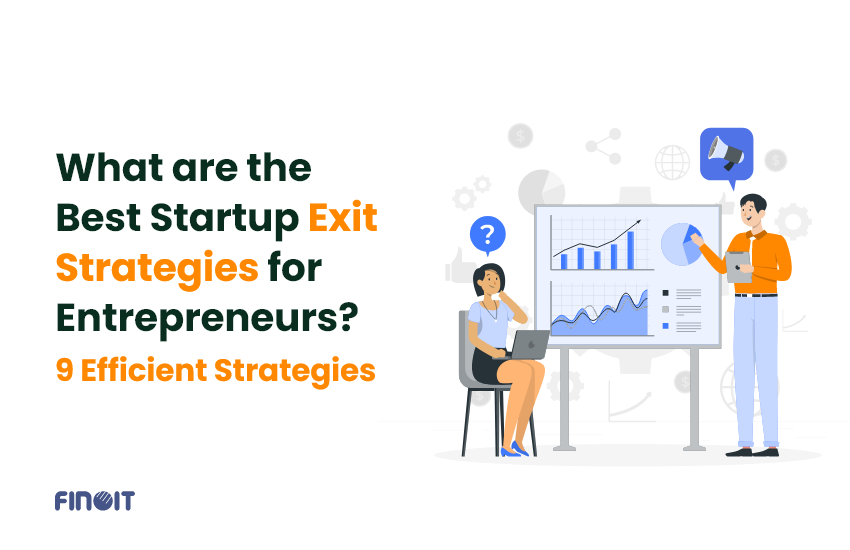What are the Best Startup Exit Strategies for Entrepreneurs? 9 Efficient Strategies

As an entrepreneur, to make exit plans from the business that you have put your heart and soul into might seem counter intuitive. However, how would you recoup you stakeholder’s money in case your business fails? Also, some entrepreneurs are triggered by the zeal to create something new; once the production phase is over, the same zeal, turns into a tedious cookie-cutting process. What would be your approach then. Eventually, you might have to let go of your business for retirement, financial gain, or to move on to something else.
A clearly defined exit strategy hence is a crucial component of your business that may be your off-boarding ticket, whenever you need it. It can significantly allure your investors, who often look for a backup for return on their investment. By planning an exit, startups can navigate the business landscape more effectively, ensuring sustained growth and a successful transition when the time is right or if situations are unfortunate. This structured approach fosters a positive organizational culture and paves the way for a smooth transition, benefiting not just the owners and investors but the entire organization.
9 Best Exit Strategies for Startups
Would you believe if we say that pf approximately 15% of the startups that manage to sustain themselves in the winning race can potentially achieve a successful exit with a value of $50 million or more? Research conducted by Startup Genome substantiates this fact. Consequently, another survey report by CBinsights published in 2023, projects Europe as the leader in the global startup exit landscape, accounting for 38% of exits annually. Following the list are the US and Asia, with an exit rate of 35% and 16%, respectively.
Keeping in mind the cruciality of these plans for your entrepreneurial endeavor, here are some exit strategies that will help you in times of need
1.Initial Public Offering (IPO)
As per a report by CB Insights, the global IPO market is witnessing a steady rebound, with a 24% hike in IPOs. While IPOs can be an effective way for startups to raise capital and boost their visibility, they can also be intricate and costly. They may not be suitable for all businesses. In an IPO, a company issues its shares to the public by getting listed on the stock exchange for the first time. This allows institutional investors to see a return on investment through improved equity values, but the founders’ involvement with the company may not end.
It is worth remembering that IPOs can be expensive and time-consuming as they involve substantial legal, accounting, and underwriting fees. Moreover, public companies are subject to stringent regulatory compliance, reporting, and disclosure requirements, which can be an ongoing financial burden. Going public means sharing ownership with many shareholders, which can result in founders and early investors losing some control over the company’s direction. Public companies face market volatility and scrutiny. Negative news or performance can lead to rapid stock price declines. However, after an IPO, entrepreneurs can sell their equity to the public and exit the business. IPOs used to be the preferred exit mode, but since the Internet bubble burst in 2000, the IPO rate has declined.
Merger/Acquisition
Mergers and acquisitions (M&A) are two common types of startup exit. Although they are usually grouped together, mergers and acquisitions are two distinct exit events. In an acquisition, one company is acquired (or purchased) by another. In a merger, the two companies converge into one. Both parties will still control a share of the ownership in a merger. There is usually no infusion of capital, and a startup may or may not become more liquid for its founders and investors. M&A occurs when two or more companies combine to form a new company or when one company acquires another. This strategy can give startups access to new markets, resources, and expertise. However, according to a recent report by CB Insights, M&A deals have declined by 8% in the global startup ecosystem.
In the event of a merger, typically, both companies are merged and operated as a new single entity. The previous form of neither company would continue to exist. Usually, new management and a new business model are put in place. However, in an acquisition, your startup may continue operating as is or be dissolved into the acquiring company. In this phenomenon, some leaders take their earnings and walk away, some may negotiate a role and become part of the acquiring company.
Dealings in acquisitions can occur in cash, equity in the acquiring company, or a mix of the two. For example, when Facebook acquired Instagram in 2012 and WhatsApp in 2014, they completed the transactions in cash and stock. However, when Uber acquired Postmates in 2020, they did so in all stock.
Partner/Investor Buyout
When startup founders want to exit their company, they may pursue partner and investor buyouts. This is especially common in startups with multiple co-founders or investors. In private companies, the remaining partners and investors are often given the first opportunity to buy out a departing co-founder. Partnership agreements often include clauses that allow for this. The buyout process can be complex and require regulatory approvals, which can delay the completion of the process and increase transaction costs. It’s important to remember that buying out partners or investors can reduce the diversity of opinions and expertise within the company. This can hurt growth and decision-making. Additionally, disagreements and conflicts may arise during the buyout process, mainly if there are differing opinions on the company’s valuation or the buyout terms.
1.Management and/or Employee Buyout (MOB/MOEB)
A management buyout is when a business is purchased by its core management team, often with the help of a third party like a lender or a private equity fund. The buyout size can vary significantly depending on the business’s complexity and size. Still, the one thing all management buyouts have in common is that the core management team takes an equity stake in the company. Depending on the current shareholders’ intentions, the buyout can represent a controlling or full acquisition stake. According to Kenneth Johnston, Partner, Valuation Delloitte:
“Selling to management has its advantages, including the ability to preserve confidentiality and limit due diligence; however, the valuation obtained tends to be lower than other options due to management’s limited access to capital. As a result, the seller is often required to finance part of the purchase price through a vendor take back.”
The motivation behind the buyout is usually the founder’s retirement and a desire to let the current management team take part in the company’s future growth. The management team often funds the buyout with some of their own capital to ensure they are actively incentivized to grow the company. The amount management requires is typically enough to ensure their ongoing commitment to the business’s success. Due to competing interests, buyouts can be complex transaction processes, but with clear communication and reasonable expectations, all parties can ensure a smooth transition. The buyout stakeholders have different motivations, but they all come down to one thing: value.
Employee Stock Ownership Plan (ESOP)
If you’re a business owner considering ESOP as your exit plan, it can assure your value proposition. By creating an ESOP trust that holds shares of company stock on behalf of employees, you can sell all or part of your business using borrowed funds, seller financing, or a combination of both. According to the National Center for Employee Ownership (NCEO), there are approximately 6257 e companies that have employee stock ownership plans (ESOPs) covering more than 1.5 million participants as of 2023. Although there has been a decline in the number of plans since the start of the 21st century, there has been an increase in the number of participants.
Selling your business to an ESOP provides liquidity, a significant tax advantage, and the flexibility and choice to remain involved in the business as a leadership employee. This ensures that a smooth transition and succession plan can be executed. However, setting one up can be complex because ESOPs are subject to regulatory oversight as a qualified retirement benefit. You’ll need specialized guidance from experienced advisors, a designated fiduciary ESOP trustee, and long-term, expert third-party management.
Selling to an ESOP also helps ensure a predictable timeline for sale and control over your exit and succession planning preferences, which are some of the benefits of this option. Additionally, ESOP sales have mechanisms to ensure that a fair price is paid for the company.
Special Purpose Acquisition Companies (SPACs)
Special purpose acquisition companies (SPACs) have become a popular vehicle for startups to go public. SPACs are companies that are created with the sole purpose of acquiring another company and taking it public. They have become increasingly popular in recent years and are currently one of the hottest trends on Wall Street. During the financial year of 2020-2021, SPAC IPO filings reached a record high despite their growing popularity over the past decade. According to reports, in 2021, SPACs raised capital through 613 IPOs alone in a single year. Some notable companies that have gone public through SPACs include DraftKings, Nikola Corporation, and Virgin Galactic.
The process of going public through a SPAC involves the SPAC launching an initial public offering (IPO) to raise funds. Once you are shared, it begins finding a target company to acquire. After identifying a potential target, the SPAC completes the acquisition with the target company. This process is a reverse merger, as the target company effectively merges with the SPAC and gains access to the public markets. One advantage of going public through a SPAC is that it can be faster and less expensive than a traditional IPO. Additionally, SPACs often offer more flexible terms than conventional IPOs, which can appeal to startups.
However, it’s important to note that SPAC deals typically include a lock-out period, during which early investors and insiders are prohibited from selling their shares. This lock-out period can be longer than those of a traditional IPO, which may be a consideration for startups that are looking to go public quickly.
1.Legacy Exit
Also known as Family succession or succession planning, is the process of transferring a business from one generation to the next. It is a common exit strategy for small businesses, particularly family-owned and operated ones. The process typically involves transferring ownership and management of the business to family members. Founders can achieve this transfer through a variety of methods, such as a sale of the business, a gift, or a combination of the two. The transfer of management can be a gradual process that takes place over several years, or it can be sudden, depending on the circumstances of the business and the family.
It is important to consult with legal and tax professionals when planning for family succession. The transfer of ownership and management can have significant tax and legal implications, and it is crucial to ensure that the transfer is structured in a way that maximizes tax efficiency and protects the interests of all parties involved. While family succession is a popular exit strategy for small businesses, it may not be suitable for larger businesses or startups that require liquidity events for investors.
Family succession does not typically provide a liquidity event, which can make it difficult for investors and other stakeholders to cash out of the company. Planning for family succession is a complex process that requires careful consideration of a range of factors. No matter in which end of the plan you are located, you should consider the interests and capabilities of the family members, the financial needs of the concerned business, and the potential tax and legal implications of the transfer. It is also important to develop a plan for managing any conflicts that may arise during the transfer process, as mixing business with personal relationships can be challenging.
2.Filing a Bankruptcy
Bankruptcy is often considered as the last resort for startups to exit the market. Despite the undesirable nature of this option, it is sometimes necessary for startups that face failure. In such cases, founders may file for bankruptcy protection to relieve themselves of their startup’s debts and financial liabilities. This process will likely require them to relinquish all business assets and may negatively impact their credit rating.
Conclusion
Developing and executing an exit strategy is a crucial process for startups. It helps to align stakeholders’ interests, manage risks, enhance the company’s overall value, and adapt to changing market conditions. However, choosing the best exit strategy for your startup requires carefully evaluating several factors, such as the company’s industry, stage of growth, and financial condition. By analyzing all available options, you can decide how best to exit your business.
At Finoit, we are much more than just service providers. With us, you can build a scalable business, that will support your exit strategies in the future. Connect with us today!

